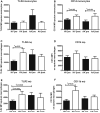Atopic asthmatic patients have reduced airway inflammatory cell recruitment after inhaled endotoxin challenge compared with healthy volunteers
- PMID: 22770265
- PMCID: PMC3652253
- DOI: 10.1016/j.jaci.2012.05.026
Atopic asthmatic patients have reduced airway inflammatory cell recruitment after inhaled endotoxin challenge compared with healthy volunteers
Abstract
Background: Atopic asthmatic patients are reported to be more sensitive to the effects of environmental endotoxin (LPS) than healthy volunteers (HVs). It is unknown whether this sensitivity is due to dysregulated inflammatory responses after LPS exposure in atopic asthmatic patients.
Objective: We sought to test the hypothesis that atopic asthmatic patients respond differentially to inhaled LPS challenge compared with HVs.
Methods: Thirteen allergic asthmatic (AA) patients and 18 nonallergic nonasthmatic subjects (healthy volunteers [HVs]) underwent an inhalation challenge to 20,000 endotoxin units of Clinical Center Reference Endotoxin (LPS). Induced sputum and peripheral blood were obtained at baseline and 6 hours after inhaled LPS challenge. Sputum and blood samples were assayed for changes in inflammatory cell numbers and cytokine and cell-surface marker levels on monocytes and macrophages.
Results: The percentage of neutrophils in sputum (%PMN) in induced sputum similarly and significantly increased in both HVs and AA patients after inhaled LPS challenge. However, the absolute numbers of leukocytes and PMNs recruited to the airways were significantly lower in AA patients compared with those seen in HVs with inhaled LPS challenge. Sputum levels of IL-6 and TNF-α were significantly increased in both cohorts, but levels of IL-1β and IL-18 were only significantly increased in the HV group. Cell-surface expression of Toll-like receptors 4 and 2 were significantly enhanced only in the HV group.
Conclusions: The airway inflammatory response to inhaled LPS challenge is blunted in AA patients compared with that seen in HVs and accompanied by reductions in airway neutrophilia and inflammasome-dependent cytokine production. These factors might contribute to increased susceptibility to airway microbial infection or colonization in AA patients.
Copyright © 2012 American Academy of Allergy, Asthma & Immunology. Published by Mosby, Inc. All rights reserved.
Figures




References
-
- Peden DB. The epidemiology and genetics of asthma risk associated with air pollution. J Allergy Clin Immunol. 2005;115:213–20. - PubMed
-
- Alexis NE, Lay JC, Zeman K, Bennett WE, Peden DB, Soukup JM, et al. Biological material on inhaled coarse fraction particulate matter activates airway phagocytes in vivo in healthy volunteers. J Allergy Clin Immunol. 2006;117:1396–403. - PubMed
-
- Becker S, Fenton MJ, Soukup JM. Involvement of microbial components and toll-like receptors 2 and 4 in cytokine responses to air pollution particles. Am J Respir Cell Mol Biol. 2002;27:611–8. - PubMed
Publication types
MeSH terms
Substances
Grants and funding
LinkOut - more resources
Full Text Sources
Medical
Miscellaneous

